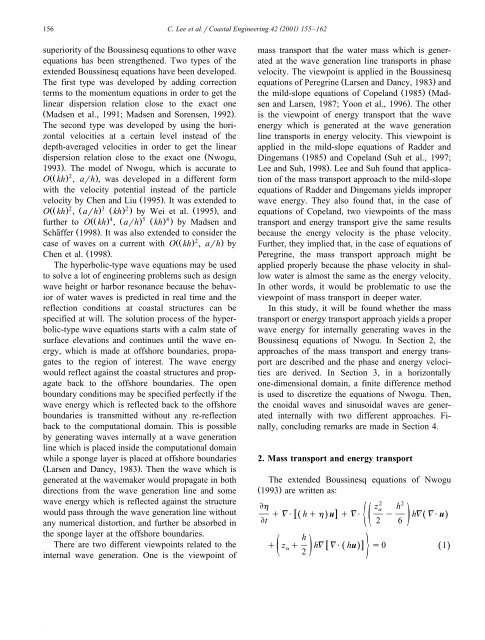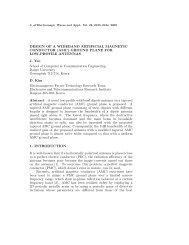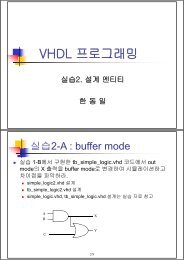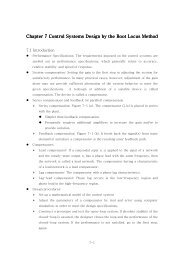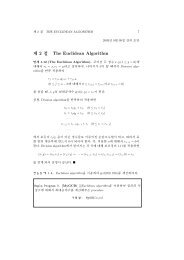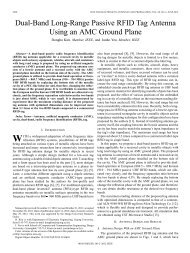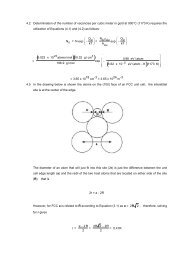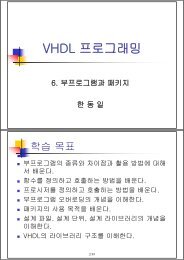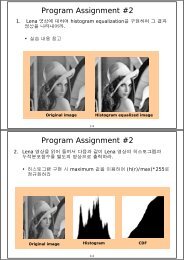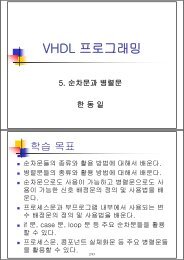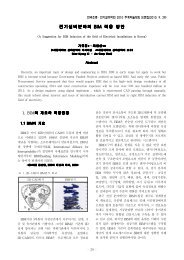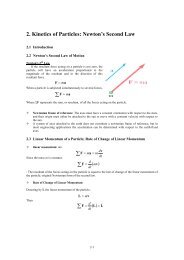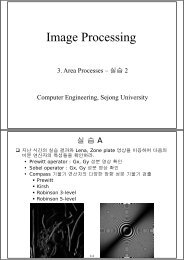Internal generation of waves for extended Boussinesq equations
Internal generation of waves for extended Boussinesq equations
Internal generation of waves for extended Boussinesq equations
You also want an ePaper? Increase the reach of your titles
YUMPU automatically turns print PDFs into web optimized ePapers that Google loves.
156<br />
( )<br />
C. Lee et al.rCoastal Engineering 42 2001 155–162<br />
superiority <strong>of</strong> the <strong>Boussinesq</strong> <strong>equations</strong> to other wave<br />
<strong>equations</strong> has been strengthened. Two types <strong>of</strong> the<br />
<strong>extended</strong> <strong>Boussinesq</strong> <strong>equations</strong> have been developed.<br />
The first type was developed by adding correction<br />
terms to the momentum <strong>equations</strong> in order to get the<br />
linear dispersion relation close to the exact one<br />
Ž Madsen et al., 1991; Madsen and Sorensen, 1992 ..<br />
The second type was developed by using the horizontal<br />
velocities at a certain level instead <strong>of</strong> the<br />
depth-averaged velocities in order to get the linear<br />
dispersion relation close to the exact one ŽNwogu,<br />
1993 .. The model <strong>of</strong> Nwogu, which is accurate to<br />
OŽŽ kh . 2 , arh ., was developed in a different <strong>for</strong>m<br />
with the velocity potential instead <strong>of</strong> the particle<br />
velocity by Chen and Liu Ž 1995 .. It was <strong>extended</strong> to<br />
OŽŽ kh . 2 , Ž arh. 3 Ž kh. 2 . by Wei et al. Ž 1995 ., and<br />
further to OŽŽ kh . 4 , Ž arh. 5 Ž kh. 4 . by Madsen and<br />
Schaffer ¨ Ž 1998 .. It was also <strong>extended</strong> to consider the<br />
case <strong>of</strong> <strong>waves</strong> on a current with OŽŽ kh . 2 , arh.<br />
by<br />
Chen et al. Ž 1998 ..<br />
The hyperbolic-type wave <strong>equations</strong> may be used<br />
to solve a lot <strong>of</strong> engineering problems such as design<br />
wave height or harbor resonance because the behavior<br />
<strong>of</strong> water <strong>waves</strong> is predicted in real time and the<br />
reflection conditions at coastal structures can be<br />
specified at will. The solution process <strong>of</strong> the hyperbolic-type<br />
wave <strong>equations</strong> starts with a calm state <strong>of</strong><br />
surface elevations and continues until the wave energy,<br />
which is made at <strong>of</strong>fshore boundaries, propagates<br />
to the region <strong>of</strong> interest. The wave energy<br />
would reflect against the coastal structures and propagate<br />
back to the <strong>of</strong>fshore boundaries. The open<br />
boundary conditions may be specified perfectly if the<br />
wave energy which is reflected back to the <strong>of</strong>fshore<br />
boundaries is transmitted without any re-reflection<br />
back to the computational domain. This is possible<br />
by generating <strong>waves</strong> internally at a wave <strong>generation</strong><br />
line which is placed inside the computational domain<br />
while a sponge layer is placed at <strong>of</strong>fshore boundaries<br />
Ž Larsen and Dancy, 1983 .. Then the wave which is<br />
generated at the wavemaker would propagate in both<br />
directions from the wave <strong>generation</strong> line and some<br />
wave energy which is reflected against the structure<br />
would pass through the wave <strong>generation</strong> line without<br />
any numerical distortion, and further be absorbed in<br />
the sponge layer at the <strong>of</strong>fshore boundaries.<br />
There are two different viewpoints related to the<br />
internal wave <strong>generation</strong>. One is the viewpoint <strong>of</strong><br />
mass transport that the water mass which is generated<br />
at the wave <strong>generation</strong> line transports in phase<br />
velocity. The viewpoint is applied in the <strong>Boussinesq</strong><br />
<strong>equations</strong> <strong>of</strong> Peregrine Ž Larsen and Dancy, 1983.<br />
and<br />
the mild-slope <strong>equations</strong> <strong>of</strong> Copeland Ž 1985. ŽMad-<br />
sen and Larsen, 1987; Yoon et al., 1996 .. The other<br />
is the viewpoint <strong>of</strong> energy transport that the wave<br />
energy which is generated at the wave <strong>generation</strong><br />
line transports in energy velocity. This viewpoint is<br />
applied in the mild-slope <strong>equations</strong> <strong>of</strong> Radder and<br />
Dingemans Ž 1985. and Copeland ŽSuh et al., 1997;<br />
Lee and Suh, 1998 .. Lee and Suh found that application<br />
<strong>of</strong> the mass transport approach to the mild-slope<br />
<strong>equations</strong> <strong>of</strong> Radder and Dingemans yields improper<br />
wave energy. They also found that, in the case <strong>of</strong><br />
<strong>equations</strong> <strong>of</strong> Copeland, two viewpoints <strong>of</strong> the mass<br />
transport and energy transport give the same results<br />
because the energy velocity is the phase velocity.<br />
Further, they implied that, in the case <strong>of</strong> <strong>equations</strong> <strong>of</strong><br />
Peregrine, the mass transport approach might be<br />
applied properly because the phase velocity in shallow<br />
water is almost the same as the energy velocity.<br />
In other words, it would be problematic to use the<br />
viewpoint <strong>of</strong> mass transport in deeper water.<br />
In this study, it will be found whether the mass<br />
transport or energy transport approach yields a proper<br />
wave energy <strong>for</strong> internally generating <strong>waves</strong> in the<br />
<strong>Boussinesq</strong> <strong>equations</strong> <strong>of</strong> Nwogu. In Section 2, the<br />
approaches <strong>of</strong> the mass transport and energy transport<br />
are described and the phase and energy velocities<br />
are derived. In Section 3, in a horizontally<br />
one-dimensional domain, a finite difference method<br />
is used to discretize the <strong>equations</strong> <strong>of</strong> Nwogu. Then,<br />
the cnoidal <strong>waves</strong> and sinusoidal <strong>waves</strong> are generated<br />
internally with two different approaches. Finally,<br />
concluding remarks are made in Section 4.<br />
2. Mass transport and energy transport<br />
The <strong>extended</strong> <strong>Boussinesq</strong> <strong>equations</strong> <strong>of</strong> Nwogu<br />
Ž 1993.<br />
are written as:<br />
Eh z 2 a h 2<br />
q=P Ž hqh. u q=P y h= Ž =Pu.<br />
Et 2 6<br />
ž /<br />
½ž /<br />
h<br />
q z q h= =P Ž hu. s0 Ž 1.<br />
2<br />
a 5


